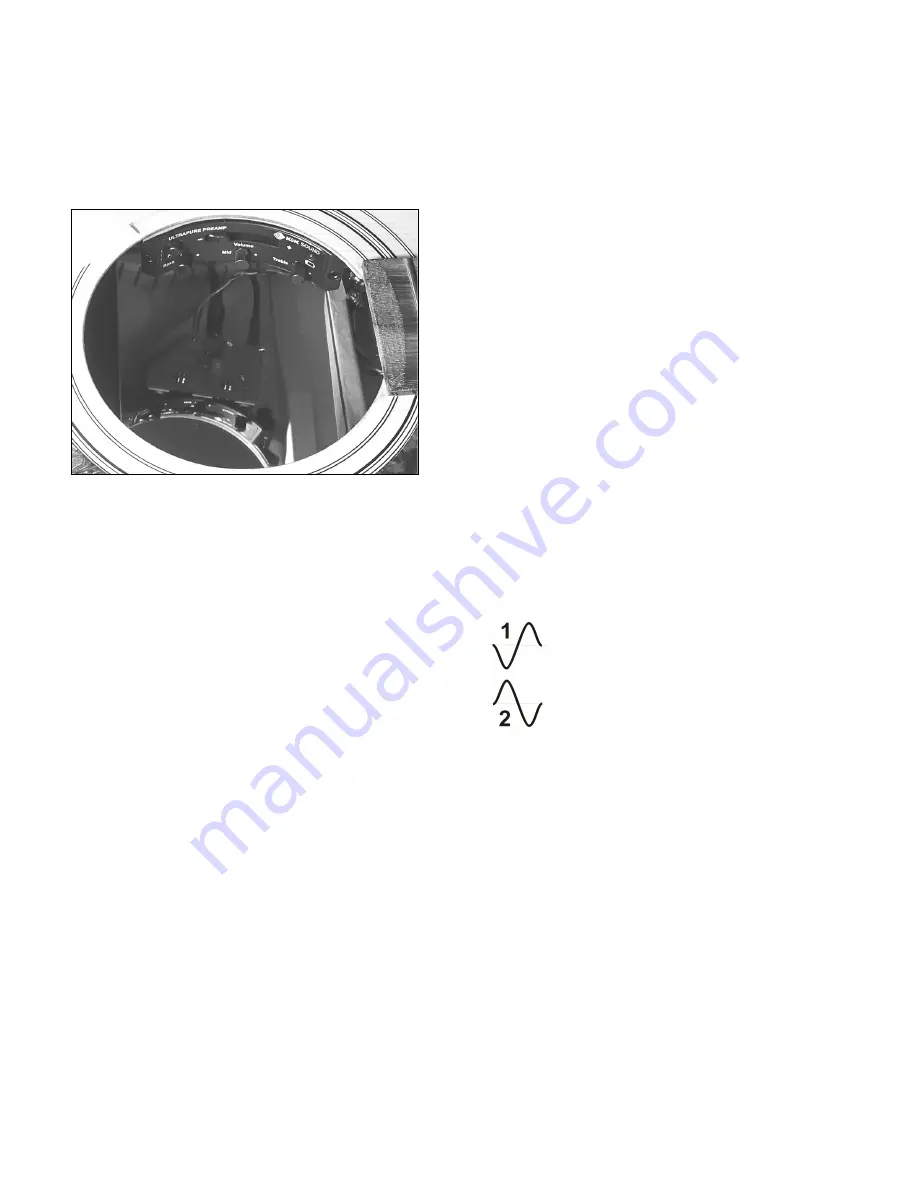
3
11.
Attach the preamp to the mounting bracket with
the 2 screws that you removed in step 4. Start
with the screw on the neck end of the preamp.
This is the narrower end with less tape. Be
gentle to avoid stressing the fresh hold of the
tape while doing this.
12.
Plug the pickup into the RCA connector on the
preamp’s input cable and stick the RCA
connection either to the side or to the bottom of
the guitar with the supplied self-adhesive Velcro
material. Secure the pickup cables with the
smaller metal clip and the output/endpin cable
with the bigger clip as shown in overview photo
on page 1.
13.
Install the endpin jack according to the pickup
manual.
14.
Stick the supplied rectangular Velcro piece to
the neck block for the battery bag (see overview
photo, p. 1).
15.
Connect the battery clip to a new 9-volt battery
(not supplied) and put it into the battery bag.
16.
Stick the battery bag to the Velcro on the neck
block (see overview photo, p. 1).
Adjustable Input Gain Control
This is a small blue trim pot that is located on the
bottom side of the preamp circuit board. It is factory
set to the middle position.
To access this trim pot you have to remove the 2
Allen screws, separate the preamp from the
mounting bracket (as described in point 4) and take
it out of the guitar.
This control sets the amount of pre-amplification and
allows using the UltraPure Preamp with a large
variety of pickup systems, including non K&K
systems. You can lower (turn counterclockwise) or
raise (turn clockwise) the input gain if necessary.
Gain and volume both have an effect on the output
volume of the preamp, but they accomplish different
tasks. The gain (also called input gain or sensitivity
control) is located at the INPUT of the circuit. It sets
the amount of pre-amplification before the signal
enters the EQ section. The volume control is located
at the OUTPUT (the very end of the circuit) and
simply allows you to adjust the volume.
To get the best performance out of the UltraPure
Preamp, the input gain can be set to fit the
instrument you are using. An instrument with a high
output signal will require less gain than one with a
weaker output. The gain is factory set to a “happy
medium” position that will most likely be just fine if
you use the Pure Pickup. Too much input gain will
distort the sound when you strike the guitar hard,
too little input will raise the noise floor of your
amplification system.
Phase Switch
Phase switches are usually marketed as a feedback-
controlling device, but they accomplish more than
just that. Phase determines at what point in time a
sound wave has it’s peak or bottom.
This picture shows two simple (identical)
sine waves, but the wave on the bottom
(2) is inverted in respect to the wave on
top (1). Interestingly enough, if these 2
waves were played back simultaneously,
they would cancel each other out and no
sound be heard. Amplification systems and effect
pedals may or may not invert the phase with
respect to the signal sent in.
Every acoustic instrument projects sound waves in a
certain phase. The phase that is projected from the
amplified speaker source needs to be "in phase"
(not inverted) with the acoustic instruments’ own
sound waves or the result will not be optimal. If the
amp projects the inverted phase, the acoustic
instrument will fight its own sound and balanced
tone cannot develop. Round and warm tone is only
achieved when acoustic and amplified sound
oscillate in the same phase.
The UltraPure’s phase switch allows for instant
correction of this problem. Play your instrument and
flip the phase switch back and fourth. You will
experience a fuller and warmer tone one way or the
other (in most cases it will be correct when the






















